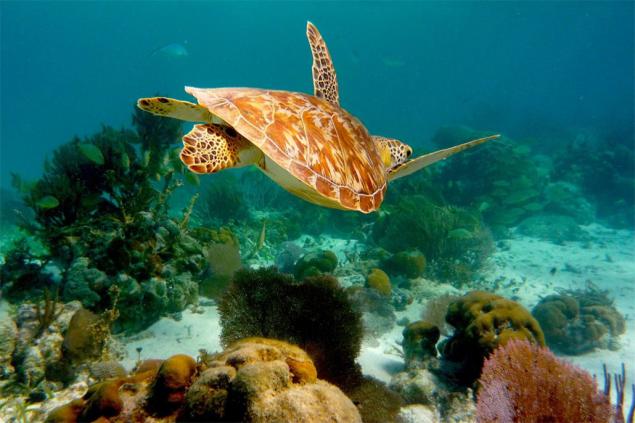Action safeguards ecosystems while promoting sustainable fishing
In a bold step for the sustainability of its fisheries and the world’s second largest barrier reef, the government of Belize has approved a plan to set aside 10% of its territorial waters as no-take marine protected areas (MPAs), nearly tripling the size of its existing zones.
At its sitting on 2nd April 2019, Cabinet approved a joint proposal from the Ministry of Fisheries, Forestry, the Environment and Sustainable Development, and the Ministry of Tourism and Civil Aviation, to increase the area of fisheries replenishment zones in Belize’s waters in order to protect important fish spawning sites and to further ensure the sustainability of the fisheries sector.
This major expansion of the MPAs is coupled with the Caribbean nation’s move to adopt a national secure fishing rights program in 2016. It represents the culmination of more than six years of work led by The National Conservation Zone Expansion Steering Committee, which includes the Belize Fisheries Department, Environmental Defense Fund, Wildlife Conservation Society, The Nature Conservancy, Belize Federation of Fishers, Belize Fishermen Cooperatives, Coastal Zone Management Authority and Institute, Belize Forest Department, National Protected Areas Secretariat, Belize Coast Guard, Healthy Reefs Initiative, Association of Protected Areas Management Organizations and Toledo Institute for Development.
Replenishment zones (also referred to as no-take areas) are a globally recognized fisheries management tool used to protect habitats where important biological functions occur, such as spawning, in order to safeguard the reproductive capacity of fish species. Globally, it is agreed among scientists, practitioners and governments that countries should strive to protect 10% of its waters as no-take areas.
This goal of 10% is articulated under the United Nations Sustainable Development Goal 14 – Life Under Water and is also contained in the Aichi Biodiversity Targets. Expansion of the replenishment zones in Belize is necessary to address the current challenges facing the national fishery and tourism industries brought about by increasing pressures from an ever-growing number of fishers and is also necessary to avert future challenges such as declining fish stocks.
“This is a truly remarkable accomplishment that is setting an example for the rest of the world to follow,” said Katie McGinty, Senior Vice President for Oceans at Environmental Defense Fund. “The combination of significant marine protected areas and managed access for fishers will help protect some of the most important ecosystems in the world while ensuring sustainable fishing can continue to provide food, nutrition and livelihoods to the thousands of Belizeans who rely on these valuable natural resources.”
The total area of Belize’s waters under no-take status will now increase from 4.5% to 11.6%. The expansion will occur in the open or deep-sea area, with depths ranging from 200m to 3000m. These areas include the most underrepresented habitats in the current marine protected areas (MPAs) system of Belize. Also included is the expansion of a no-take area into the Exclusive Economic Zone exactly south of the Sapodilla Cayes Marine Reserve to protect the biological functions that take place in the extensive coral reef complex, known as the Corona Reef, at the southwestern terminus of the Cayman Trench.
Over more than six years, an international collaboration of scientists led by Belizeans worked to identify zones that can protect marine habitat and allow for recovery of degraded ecosystems, while at the same time helping to replenish fish stocks. A lengthy process of consultations with stakeholders, facilitated by Government of Belize, Belizean community NGOs, EDF and other international NGO partners, resulted in widespread support for these new marine protected areas, and a commitment to stewardship from coastal communities.
The expansion of marine protected areas will have an impact well beyond fisheries. It is a crucial step for Belize to meet the aspirations of its national development plans and its international commitments under the United Nation’s Sustainable Development Goals.
This new expansion comes as Belize was recently recognized for the impact of its sustainable fisheries. According to the most recent ‘Mesoamerican Reef Report Card’ by Healthy Reef for Healthy People, Belize’s no-take zones show growing fish populations and biodiversity. That biodiversity is magnificent and unique—mangroves, corals, seagrass and cayes support populations of conch, lobster and a variety of reef fish.
“Together, managed access and no-take zones are designed to help rebuild fish populations while protecting critical habitat,” said Nicanor Requena, Belize Project Manager at Environmental Defense Fund, “The people of Belize deserve tremendous credit for their vision and perseverance to protect their natural heritage while encouraging sustainable fishing practices so that people and nature can prosper together.”
These new replenishment zones were identified through an evidence-based process led by the Fisheries Department along with Belizean and international scientific partners to ensure the zones protect habitat and life-cycle processes to replenish fisheries stocks. The zones were determined based on maximizing potential benefits to the national interest while minimizing disruption to the livelihoods and culture of the fishing community.












